- Author Matthew Elmers [email protected].
- Public 2023-12-16 21:49.
- Last modified 2025-01-24 09:17.
The whole essence of multiple launch rocket systems is to send a large amount of ammunition to the target at a time. Many missiles are capable of covering a large area and causing significant damage to the enemy located there. Different systems of this class differ in the quantitative indicators of the salvo produced, but none of them can compare in this parameter with the Jobaria Multiple Cradle Launcher complex, created by the United Arab Emirates industry.
According to reports, the development of a new project of a promising MLRS with uniquely high firepower started no later than the beginning of this decade. The creation of new military equipment was carried out by Jobaria Defense Systems (JDS), part of the Tawazun Group. At the beginning of this decade, the development company completed the design and built prototypes of equipment. Soon they were shown for the first time to specialists and the general public. Given the specific characteristics and capabilities of the presented equipment, it should not be surprising that it aroused increased interest from the military, experts and military enthusiasts.
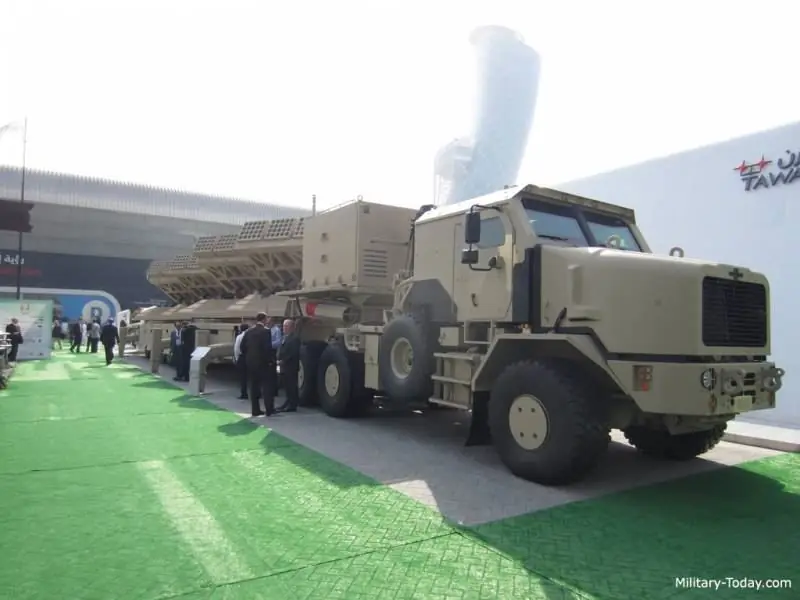
JDS Multiple Cradle Launcher at IDEX 2013. Photo: Military-today.com
The project, which received the official name Multiple Cradle Launcher or MCL, was based on an essentially simple idea of a significant increase in the firepower of a multiple launch rocket system. It was proposed to increase the characteristics of a combat vehicle in the most obvious way, namely by increasing the number of missiles in one salvo. Nevertheless, a seemingly simple method required the development of rather complex systems that gave the finished equipment an unusual appearance and led to ambiguous characteristics.
The need to obtain the maximum possible salvo size did not allow the new rocket artillery sample to be made self-propelled. The complex with launchers of the required parameters was placed only on a large and long semi-trailer platform. In this regard, the MLRS includes a truck tractor with the required characteristics, the task of which is to deliver the semitrailer to the position and then leave it.
As follows from the available data, the architecture of the JDS Multiple Cradle Launcher multiple launch rocket system allows the use of tractors of different models. So, in the available photographs from the tests, MAN machines were captured, and for the first time publicly demonstrated at exhibitions, the systems were moved using the tractors of the American company Oshkosh Defense. In fact, the customer has the opportunity to independently choose a tractor from the machines available on the market that meet the existing requirements.
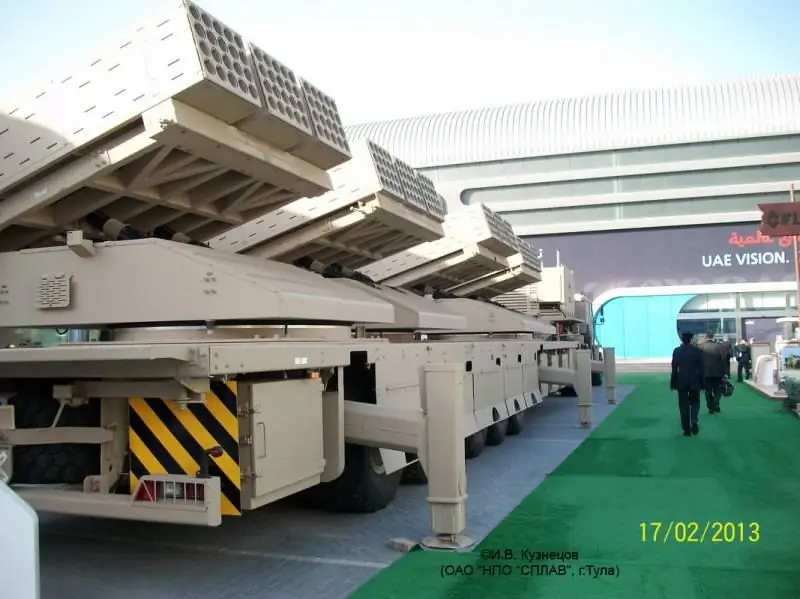
Semi-trailer with launchers. Photo Rbase.new-factoria.ru
According to published data, trucks with an armored cab have been demonstrated during past exhibitions. These were bonneted vehicles with a three-seater cockpit. The armor of the 2nd level according to the STANAG 4569 standard was used, which protects people from automatic bullets and shrapnel. In addition, the cockpit is equipped with air conditioning and collective protection against weapons of mass destruction.
The basis of the actual multiple launch rocket system is a five-axle (!) Semi-trailer, which houses all the necessary equipment. The main element of the trailer is a long rectangular platform with a raised front section, which is necessary for installing the king pin. On the front of the platform is a large rectangular armored hull of the auxiliary power unit, which is necessary for the power supply of weapons and related systems. The rest of the platform is given for the installation of four launchers. In the front part of the semi-trailer, under the main platform, there are several boxes for transporting property. The semi-trailer wheels are covered with large metal shields. Behind them, additional transport boxes are provided.
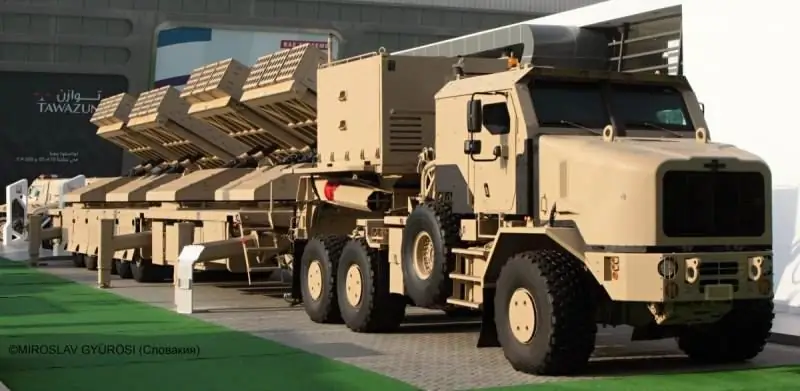
To stabilize the MLRS, it needs a large number of outriggers. Photo Rbase.new-factoria.ru
The existing wheeled chassis cannot provide the required stability when firing, which is why the semi-trailer received stabilization means. At the front of the platform, in front of the wheels, there are three pairs of retractable hydraulic outriggers. The fourth pair is placed behind the wheels. When deployed to a firing position, the supports are brought out to the sides and lowered to the ground, as a result of which the semi-trailer is suspended in the air.
Outrigger supports are equipped with hydraulic cylinders, the working fluid for which is supplied by the pump of the auxiliary power unit. In addition to it, there is a generator in the front body of the semi-trailer, which produces alternating current with a voltage of 380 V. Electricity is necessary for the operation of some drives of the launchers. The pump and generator are connected to a separate low power diesel engine. For its operation on the semi-trailer there is its own tank for 200 liters of fuel.
MLRS Multiple Cradle Launcher is equipped with four separate launchers at once. Each such device is based on a rectangular support platform with a wedge-shaped front profile. The platform is pivotally installed and can rotate around a vertical axis due to electric motors. In the stern of this platform, there are hinges for installing a swinging artillery unit. The latter has a large frame structure platform capable of moving in a vertical plane. Raising the launcher to the desired angle is carried out using two hydraulic cylinders. A specific feature of the exhibition complexes was the open placement of fire control cables. Despite the presence of large armored units, the platform and the swinging parts were connected by cables that passed outside and did not have any protection.
The designers of Jobaria Defense Systems have proposed an interesting architecture of the launcher, which allows to obtain the maximum possible performance when using ready-made unified components. On the swinging platform there are mounts for three identical transport and launch containers that can accommodate unguided missiles. With their help, the missiles are delivered to the firing position and then sent to the target. Reloading MLRS is carried out by simply replacing empty TPKs with new ones. To facilitate replacement, the container has a set of loops for lifting by crane.
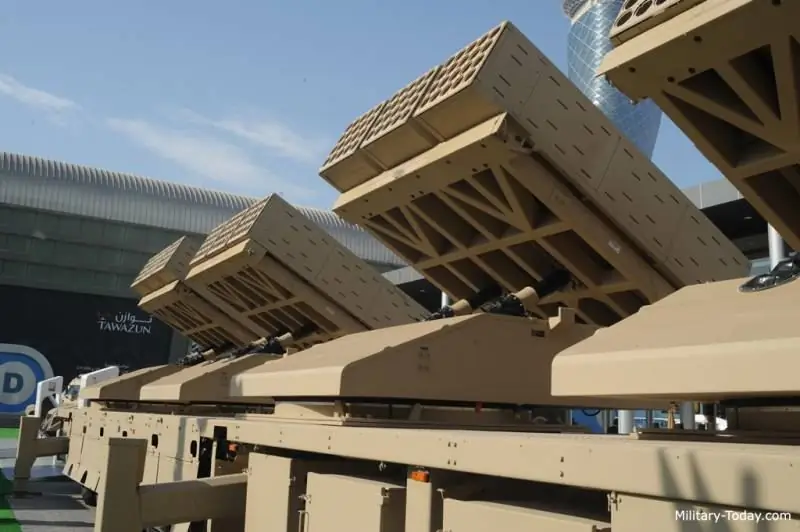
Launchers close-up. Photo Military-today.com
The transport and launch container from the JDS Multiple Cradle Launcher complex is a protected metal rectangular block with the required dimensions. Inside the common body there are 20 launch tubes for unguided rockets (five rows of four guides). The guides are made in the form of pipes with two longitudinal spiral grooves on the walls. With the help of the latter, the initial spinning of the projectile is performed at launch.
Guidance of launchers is carried out synchronously or differentiated by commands from the console located in the cockpit. With the help of electric motors, the platforms are turned in azimuth at an angle of up to 90 °; hydraulics provides lifting of the swinging parts from the TPK to the required angle. The launch is controlled by electrical impulses from the remote control.
The crew of the Jobaria Multiple Cradle Launcher combat vehicle consists of only three people. They are located in the cab of the tractor and have all the necessary equipment for preparation for shooting and firing. Shooting and aiming are carried out using a remote control system. If necessary, a remote control can be used for the same purposes. The calculation of guidance angles is carried out by an automated fire control system associated with modern navigation equipment. To determine their own position, the crew must use an inertial navigation system or instruments that use signals from the GPS satellites. The use of its own set of meteorological instruments is provided.
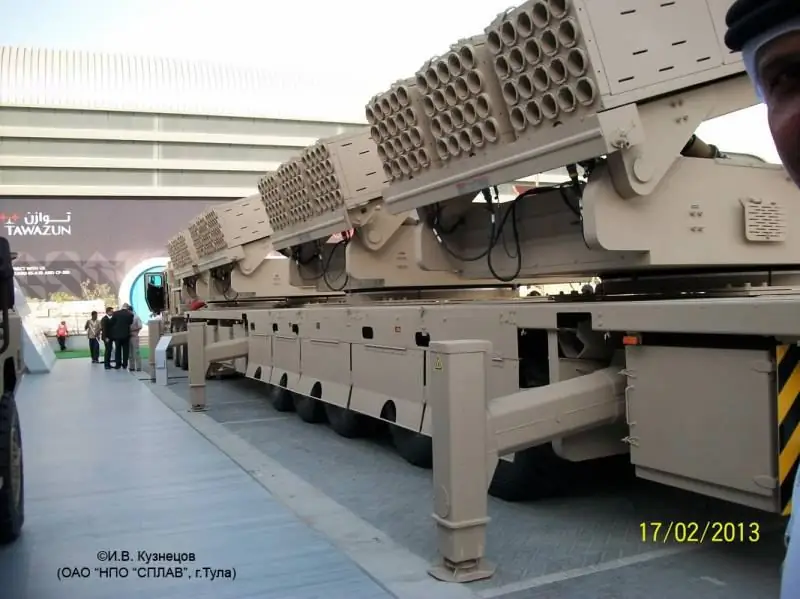
Launchers, rear view. The open cabling is surprising. Photo Rbase.new-factoria.ru
On board the tractor there are communication facilities for exchanging data and obtaining the required target designation. Target data can be received and transmitted to other machines. Due to this, the complex can operate both independently and as part of compounds.
The previously presented configuration of a multiple launch rocket system implied the use of Turkish-developed TR-122 unguided missiles. These products represent the next version of the Soviet BM-21 Grad system shells. Rockets with a caliber of 122 mm and a length of about 3 m have a mass of up to 71.6 kg and are equipped with solid-propellant engines. Depending on the modification, such a projectile is capable of delivering a high-explosive warhead or a warhead with ready-made striking elements to a range of 16 to 40 km.
Each transport and launch container has 20 missile guides. The swinging part of the launcher is capable of carrying three such TPKs. Four launchers of one Multiple Cradle Launcher are carrying 240 missiles. The unique size of the ammunition load, as well as the possibility of separate guidance of four launchers, allow one combat vehicle of a new type to replace a battery of four BM-21 MLRS or their direct counterparts.

Start guide. Photo Rbase.new-factoria.ru
After arriving at the intended firing position, the crew of the complex needs several minutes to deploy. During this time, the auxiliary power unit is launched, the semi-trailer is hung on the outriggers and the launchers are guided. Further, having received an order, the calculation can open fire. Each of the four launchers can fire up to 2 shots in 1 second. It takes at least half a minute to shoot three TPKs. Depending on the assigned fire mission, the JDS MCL MLRS can use four launchers simultaneously or sequentially. A full volley of 240 shells at one point allows you to destroy targets in an area of about 4 square kilometers. It takes a few minutes to roll up to leave the position.
After the use of the transported ammunition, the combat vehicle needs to be reloaded. To perform such operations, a special transport-loading machine was developed. All TZM special equipment is based on a five-axle semi-trailer similar to that used for the transport of launchers. The semi-trailer can accommodate two cranes of the required lifting capacity. Near them there are places for transporting several containers of missiles. A full recharge takes about 30 minutes.
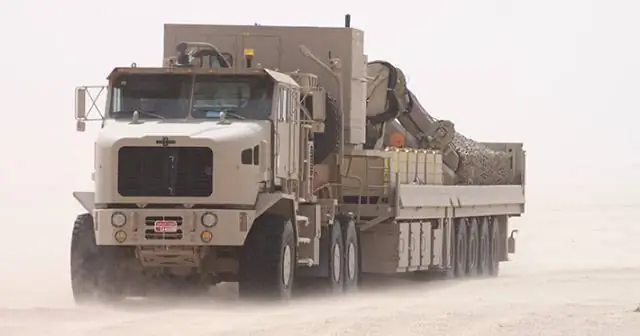
Transport and loading vehicle of the JDS MCL complex. Photo Armyrecognition.com
When using a three-axle Oshkosh truck tractor, the total length of the complex in the stowed position reaches 29 m. The total width is 4 m, the height is 3, 8 m. The combat weight of the complex is 105 tons. The MLRS can reach a relatively high speed on the highway. With full weight, the cruising range reaches 450 km. Due to the use of specific running gears, the multiple launch rocket system makes special demands on the quality of the roads. This technique is not characterized by high cross-country ability and therefore needs tracks with good coverage. It is supposed to transfer such machines, first of all, along the existing highways.
In February 2013, another international exhibition of arms and military equipment IDEX was held in the United Arab Emirates. During this event, Jobaria Defense Systems, for the first time, presented its latest development in the field of rocket artillery to the general public. On the open area of the salon, two promising complexes with missile weapons were demonstrated at once. According to foreign media reports, by the time of the first public display of the MLRS Multiple Cradle Launcher, it had already been adopted by the UAE ground forces.
Soon after the "premiere" of an interesting development, there were reports of the possible creation of new modifications of this system. The use of launchers with interchangeable transport and launch containers of missiles, at least in theory, made it possible to use unguided rockets of various types, calibers and purposes as part of the complex. Thus, the possibility of using 240 107 mm missiles was mentioned. When using 300-mm TR-300 missiles, the complex could destroy targets at ranges up to 100 km. However, until a certain time, alternative armament options for the JDS MCL existed only in the form of initial technical proposals.
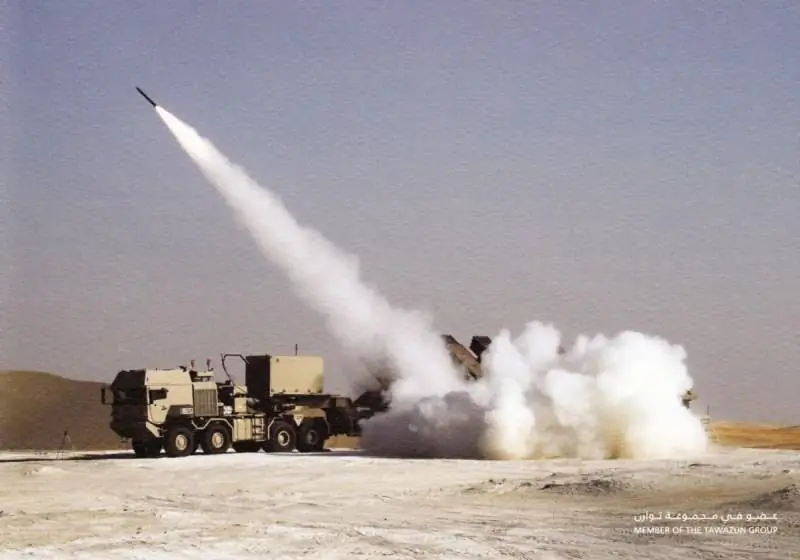
Test firing. Photo Rbase.new-factoria.ru
According to available data, no later than the beginning of 2013, the armed forces of the United Arab Emirates received the first serial MLRS of a new type. New reliable reports about the continuation of the production of this technique were not received in the future. Perhaps the customer, represented by the army, considered it inappropriate to further purchase the most interesting, but controversial samples of military equipment. Foreign countries showed no interest in such combat vehicles and did not want to order them for their armed forces.
Like any other type of weapon or military equipment, the Jobaria Multiple Cradle Launcher multiple launch rocket system has both advantages and disadvantages. The specific appearance of this sample, associated with the desire of the developers to increase certain characteristics, had a corresponding effect on the pros and cons, strengthening them in one way or another. As a result, the unique MLRS is interesting not only for its design, but also for the features associated with it.
The main plus, which became the cornerstone of the entire project, is the extremely large ammunition we carry. Four JDS MCL launchers carry 240 122 mm missiles, which is equivalent to an entire battery of traditional MLRS. Acting as a battery, a single combat vehicle with a large ammunition capacity can quickly enter position and prepare for firing. These characteristics are further enhanced by the maximum automation of various processes. The development company also made an argument in the form of a reduction in the required personnel: the crew of one Multiple Cradle Launcher is ten times smaller than all the calculations of an artillery battery with equivalent firepower.

MLRS during dynamic display at SHVUCH 20136. Photo by Thinkdefence.co.uk
In general, from the point of view of the characteristics of rockets and the combat capabilities of the entire complex, the development of the JDS company looks like another attempt not only to copy the Soviet / Russian Grad, but also to significantly increase its characteristics. In this case, to increase the combat potential, it was decided to use several unified launchers in combination with modern navigation equipment, a developed fire control system, etc. All this to a certain extent increases the accuracy of shooting and the likelihood of hitting the target. Large volley volumes, in turn, enhance the positive effect of modern equipment. The tasks of increasing firepower and overall combat effectiveness can be considered successfully accomplished.
A specific feature of the Multiple Cradle Launcher complex is the platform used in the form of a truck tractor with a semitrailer. This technique made it possible to place all the necessary units and launchers on one chassis, but these results were obtained at the cost of a noticeable reduction in mobility. A tractor with a semitrailer is quite demanding on the quality of roads and in fact cannot move off-road. Perhaps the UAE's road network makes it possible to quickly and easily transfer military equipment to the required areas, but the impossibility of normal movement over rough terrain can be considered a minus of the original project.
Mobility problems in some situations can adversely affect the results of the combat operation of equipment. For example, because of them, the MLRS may experience difficulties in reaching the required firing position and then leaving it. In this case, it simply will not be able to realize its full potential, due to the large ammunition load and high performance of fire control equipment. In addition, being tied to highways, the JDS Multiple Cradle Launcher runs the risk of being detected by an adversary, with an understandable disastrous result. All this reduces the real combat capabilities and the overall potential of an interesting sample.

Layout MLRS Jobaria TCL. Photo Armyrecognition.com
Probably, the creators of the JDS MCL project realized their mistakes and took them into account when creating new models of rocket artillery. At the IDEX 2017 exhibition held in February, for the first time, layouts of the promising multiple launch rocket system Jobaria TCL were presented. The proposed combat vehicle is based on existing developments and retains some of the features of the already known complex. At the same time, it was decided to use some new ideas to improve technical, combat and operational characteristics. MLRS of a new type is also built on the basis of a semi-trailer, but now it has only two launchers with standard mountings for TPK 300-mm unguided missiles.
The development of various weapons and military equipment, aimed at improving the main characteristics, often leads to very remarkable results. The improvement of modern multiple launch rocket systems, pursuing similar goals, led several years ago to the emergence of a unique combat vehicle JDS Multiple Cradle Launcher. As far as is known, this technique was adopted only by the UAE army, while other countries did not order such combat vehicles. Such results, perhaps, clearly confirm the obvious fact: by no means any increase in performance makes sense and can find practical application. Nevertheless, it should be borne in mind that such conclusions are made based on the results of studying a finished piece of equipment, brought to testing and operation in the army.






